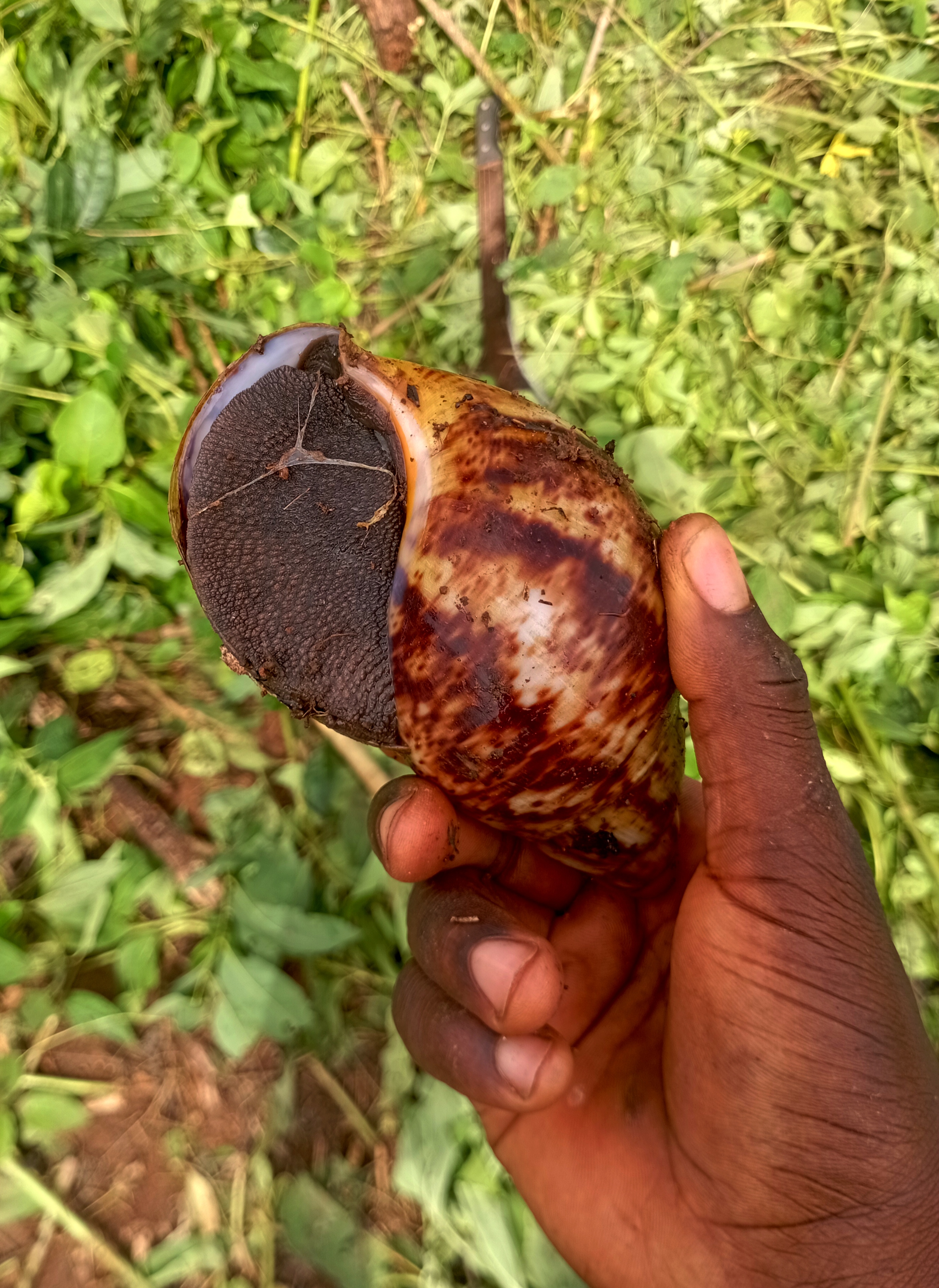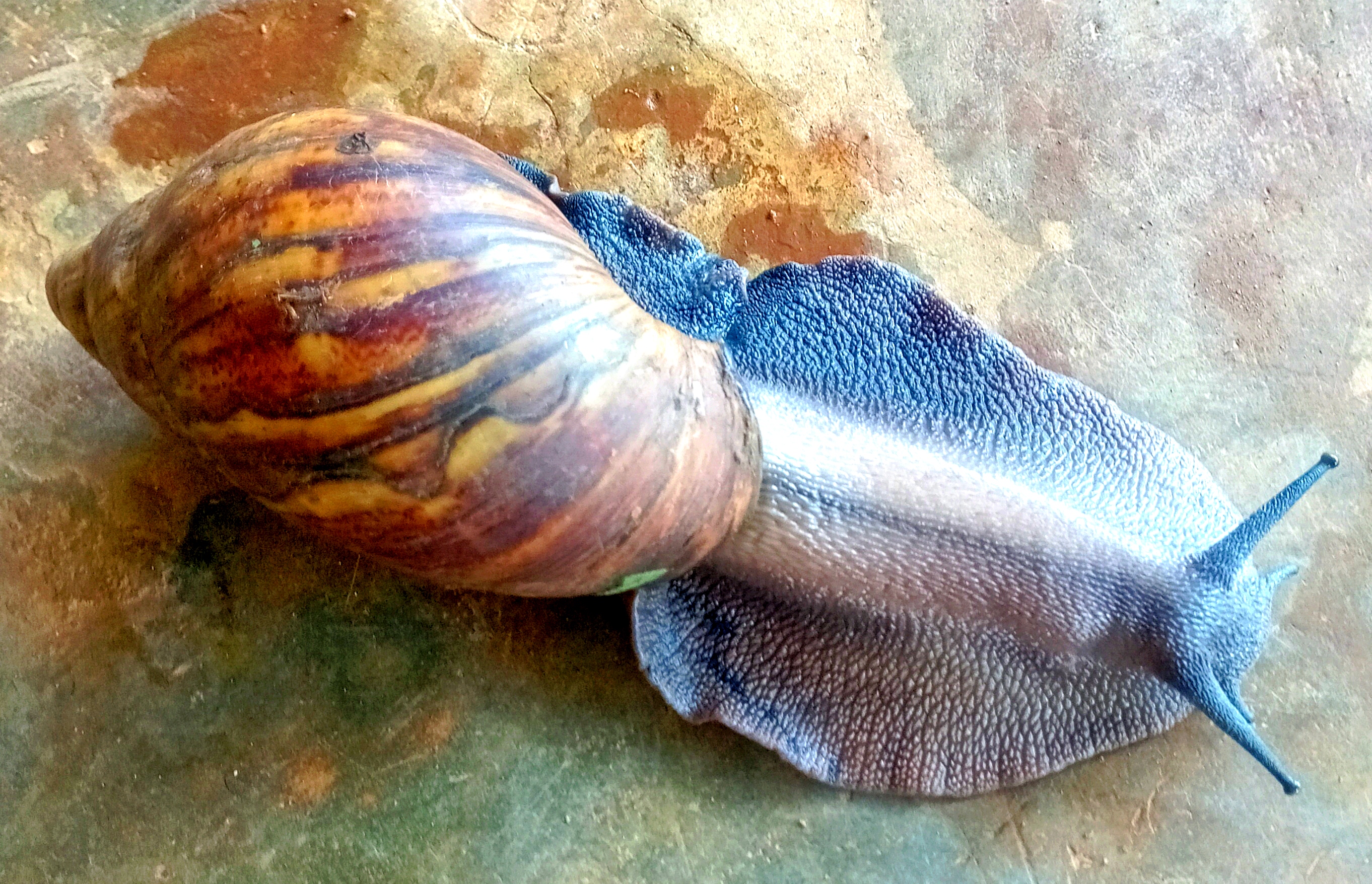WHAT I SAW WAS A HUGE GIANT AND GIGANTIC MOLLUSK
Wow! It's been a while here, how are u doing today? Today, unlike every other busy and filled-up day, I saw something that I can't just hold to myself alone. Woo, what a wonderfully created creature!

Now you see what I saw right? Ok, grab a very comfortable chair, and position it in a very nice place as I am about to reveal how I met this gentle creature named Snail. Ugh! Don't tell me you forgot to grab a bottle of water and allow at least a cup of it to pass through your trot down to your belly. Water is life my dear.
Yeah, on this very day, I decided to pay a visit to my farm and do a little clearing. Though the bushes were thick and it took me a lot of time before I can boldly say this is where a grown-up man like me has been clearing. I continued to battle with the bushes till I got under a tree where I saw the snail under the leaves. Oh my goodness! This creature is indeed beautifully made and this prompted me to share about snails right from the Yoruba interpretation of what it means to see a big snail in the cause of working on a farm land and when seen in the dream.
What did it mean when you see a big snail in Yoruba land?
When someone dreams and sees a snail in his or her dream, in Yoruba land (one of the four major ethnic groups in Nigeria), this means sluggish movement toward achieving a spectacular goal or pursuit.
My father; who happens to be a radical Yoruba man used to feel happy whenever any one of us saw a big snail while working on the farm. He used to say "This is a sign you have worked well today.
Now what's my stand regarding the two available opinions? Supporting my dad or adhering to our general traditional belief in Yoruba land.

Hmmm!
Ok, permit me to carry you along as I throw light on what snail looks like and it's special characteristics before I draw my conclusion.
SHORT DESCRIPTION OF SNAIL
A snail is a type of gastropod mollusk that belongs to the class Gastropoda. They are part of the larger category of animals called mollusks, which also include creatures like clams, mussels, and octopuses. Snails are known for their unique spiral-shaped shells, which are their external skeletons, providing protection and support for their soft bodies.
PHYSICAL CHARACTERISTICS:
- Shell: The shell is perhaps the most distinctive feature of a snail. It is made of calcium carbonate and grows along with the snail throughout its life. The size and shape of the shell can vary significantly between different snail species. Some shells are smooth, while others may have ridges, spines, or intricate patterns.
- Foot: The snail's muscular foot is the part that makes direct contact with the surface on which it moves. The foot is covered with mucus, which helps the snail glide along and protects it from abrasions. This mucus also allows them to move vertically on walls and even upside down on ceilings.
- Tentacles: Snails typically have two pairs of tentacles on their head. The upper pair contains the eyes, which are usually simple eyes that can detect light and movement. The lower pair acts as sensory organs, helping the snail feel its environment.
- Radula: Snails have a radula, a specialized organ in their mouth used for scraping and feeding. The radula consists of rows of tiny teeth that the snail uses to rasp away at plant material, algae, or detritus.
HABITAT:
Snails are found all over the world, from the depths of oceans to high mountain ranges. They inhabit a wide range of environments, including terrestrial habitats like gardens, forests, and deserts, as well as freshwater and marine ecosystems. Many snails are well-adapted to living in moist environments, as they are highly susceptible to desiccation.
BEHAVIOR AND LIFESTYLE:

- Movement: Snails move using their muscular foot, which creates a wave-like motion. They secrete mucus to reduce friction and help them slide along surfaces. Their speed can vary, but most snails move slowly, which is why they are often associated with being slow creatures.
- Nocturnal: Many species of snails are nocturnal, becoming more active at night when the temperatures are lower, and the humidity is higher, reducing the risk of dehydration.
- Herbivores: The majority of snails are herbivorous, feeding on plants, algae, and decaying organic matter. However, some snail species are carnivorous, preying on small insects or other snails.
REPRODUCTION:
Snails are hermaphrodites, meaning that each individual has both male and female reproductive organs. However, they still need to mate with another snail to fertilize their eggs. During mating, both snails exchange sperm, which they then use to fertilize their eggs and lay them in soil, leaf litter, or other suitable locations.
Ecological Importance:
Snails play a vital role in ecosystems. They help decompose organic matter, which aids in nutrient recycling. Additionally, they are an essential part of the food chain, serving as prey for various animals like birds, insects, and small mammals.
Some snail species are considered pests in agriculture because they can damage crops and garden plants. However, certain types of snails are also kept as pets or used for research purposes in various scientific studies.
Overall, snails are fascinating creatures with a diverse range of species and characteristics, adapting to various environments and playing crucial roles in their respective ecosystems.
Eating snails, also known as escargot, is a practice that has been enjoyed in various cultures around the world for centuries. While the idea of eating snails might be unusual to some, there are several potential advantages to consuming these gastropods:
Nutritional Value: Snails are a good source of protein, which is essential for building and repairing tissues in the body. They also contain essential amino acids, making them a relatively complete protein source. Snails are also rich in vitamins, minerals (such as iron, magnesium, and phosphorus), and fatty acids, contributing to a well-balanced diet.
Low in Fat: Snails are generally low in fat, particularly saturated fat, making them a healthier alternative to some other protein sources.
Omega-3 Fatty Acids: Certain snail species, particularly those from marine environments, contain omega-3 fatty acids, which are beneficial for heart health and brain function.
Sustainable Protein Source: Snails can be raised through snail farming (heliculture), which can be a more sustainable and eco-friendly protein source compared to conventional livestock like cows or pigs. Snails require less space, water, and feed to grow, and their farming has a lower environmental impact.
Culinary Delicacy: In many cultures, eating snails is considered a delicacy and is associated with special occasions or gourmet dining experiences. The unique flavor and texture of snails make them a sought-after ingredient in various cuisines.
Versatile in Cooking: Snails can be prepared in numerous ways, such as sautéed with garlic butter, served in soups or stews, or incorporated into pasta dishes. This versatility allows chefs and cooks to experiment with different flavors and preparations.
Potential Health Benefits: In some traditional medicinal practices, snails are believed to have various health benefits, including boosting the immune system, aiding digestion, and supporting skin health. However, scientific evidence for these claims is limited.
It's essential to note that while eating snails can have potential advantages, there are also some considerations and potential drawbacks. For example, some people may be allergic to snails, so caution is necessary when trying them for the first time. Additionally, the sustainability of snail consumption depends on responsible sourcing and farming practices to avoid depleting natural snail populations.
If you are interested in trying snails as part of your diet, it's best to ensure they are sourced from reputable suppliers and cooked properly to ensure safety and a delightful culinary experience. As with any new food, it's always a good idea to consult with a healthcare professional if you have any specific health concerns or dietary restrictions.
Now, may I go back to the point where I have to decide who I have to support between my dads or the general Yoruba believe? Who will you support if you are in my shoe? But at this point I have a strong feeling telling me to support my dad because of the unique and healthy characteristics embedded in snail.
Please feel free to share your stand.
Thanks and do have a love day ahead.
Wao! This is great, it's been a while I saw something as big as this
Thanks for your nice compliment. I so much appreciate the fact that you took your time to go through my content. Having a content as long as this without any tangible reward has always been a big discouragement for me. So I only do such writing once in a blue moon.
Hmm, you are welcome, but never feel discouraged, this happens sometimes but we just have to keep pushing forth
Thank you for your witness vote!
Have a !BEER on me!
To Opt-Out of my witness beer program just comment STOP below
View or trade
BEER.Hey @oluwashinaayomi, here is a little bit of
BEERfrom @isnochys for you. Enjoy it!Learn how to earn FREE BEER each day by staking your
BEER.Thank you for your witness vote!
Have a !BEER on me!
To Opt-Out of my witness beer program just comment STOP below
View or trade
BEER.Hey @oluwashinaayomi, here is a little bit of
BEERfrom @isnochys for you. Enjoy it!If you like BEER and want to support us please consider voting @louis.witness on HIVE and on HIVE Engine.
Congratulations @oluwashinaayomi! You have completed the following achievement on the Hive blockchain And have been rewarded with New badge(s)
Your next target is to reach 20000 upvotes.
You can view your badges on your board and compare yourself to others in the Ranking
If you no longer want to receive notifications, reply to this comment with the word
STOPCheck out our last posts: